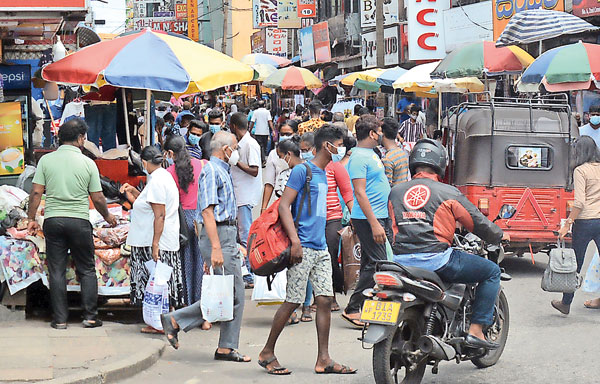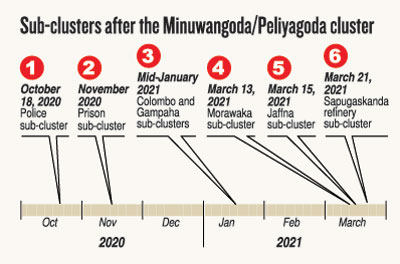News
Enjoy Avurudu with strict COVID-19 preventive measures, says DG
As frenzied shopping, family reunions and festivities of the Sinhala and Tamil New Year seemed to take off with gusto, a strong note of caution comes from the highest health official in the country.
“Be cautious as COVID-19 and its mutants are not only flying high around the world, setting off another wave of infections but sub-clusters are also raising their heads around Sri Lanka,” explained the Director-General (DG) of Health Services, Dr. Asela Gunawardena, urging that the three basic preventive measures should be adhered to stringently.
His plea is: Wear your face-mask, resort to hand-washing constantly and keep the metre-distance which would help ward off the virus from you and your loved ones.

Health Services Director General's advice to Avurudu shoppers: Strictly follow the health guidelines. Pic by M. D. Nissanka
When asked whether travel restrictions would be imposed during the season, he said they were looking at the situation closely and hoping they need not do so. This is why people need to take all precautions while celebrating the New Year.
Dr. Gunawardena talks of the new sub-clusters, the latest being the one in Jaffna. They are giving headaches to health officials.
Tracing the pathway of the virus from place to place (“adi-adi yanawa”) as ‘migrant’ hawkers go from one pola (fair) to another or from one aarthika madyasthanaya to another, he says that all positive cases, vendors and buyers, in the Jaffna sub-cluster have been isolated and their first contacts traced and quarantined. Some who had visited the pola had also attended a wedding.
The 70 positive cases detected in Jaffna have been sent to the Kilinochchi Treatment Centre while the 100 first contacts, from the fair and the wedding, are in home quarantine, it is learnt.
The detection of COVID-19 cases is due to the random RT-PCR testing that is being carried out, the DG points out, showing the route the infection has travelled along from earlier areas which include Thavalama, Hiniduma, Akuressa, Matara, Morawaka, Meepe and Piliyandala. Such testing is carried out daily at Dambulla, a very large economic centre.
Meanwhile, referring to the large number of infections in the Sapugaskanda refinery, Dr. Gunawardena said people coming from outside to carry out outsourced work had brought the infection. All positive cases have been sent to intermediate care centres, while their first contacts are being kept at the Pitipana quarantine centre.
The Sapugaskanda Public Health Inspector (PHI), S.A.P.S. Perera, said that 537 positive cases have been identified from the refinery.
Earlier, two or three positive cases were found, after which they performed 1,125 RT-PCR tests on all employees, he said, explaining that every three years, people mainly from areas other than Sapugaskanda carry out maintenance work at the refinery. The initial 2-3 cases were from among them.
These sub-clusters mushroomed as Sri Lanka’s total COVID-19 positive cases, from both the first and second waves, nudged towards 100,000, coming close to figures reported from China where the pandemic originated, with Wuhan as its epicenter.
As of Friday evening, the total number hit by COVID-19 reached 91,289 (the Epidemiology Unit), while China recorded 102,635 (the WHO).
According to Epidemiology Unit data, 88,145 patients have recovered, with 2,587 currently under treatment either in the dedicated COVID-19 Treatment Hospitals or if asymptomatic or mildly symptomatic in the intermediate care centres dotting the country.
As Sri Lanka’s death toll reached 558 (Epidemiology Unit) on Friday, China’s was 4,850 (WHO).


